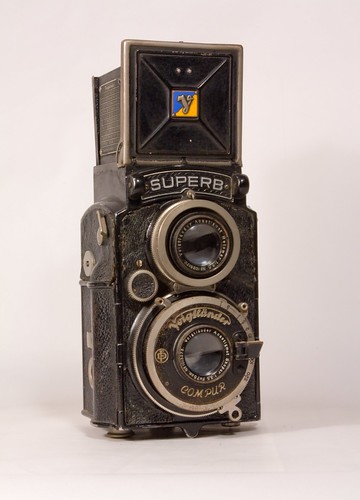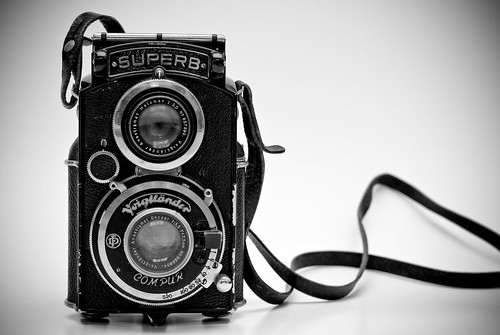Superb

|
| Superb image by willboy2010 (Image rights) |
The Superb is a well-engineered but somewhat quirky metal-bodied TLR for 6x6 cm pictures on 120 roll film, made by Voigtländer. The camera was introduced in 1933. This was six years after Franke & Heidecke made the first Rolleiflex; however, the Rolleiflex is derived from F&H's stereo Heidoscop, which is itself a copy of Voigtländer's Stereflektoskop, so it is probably unjust to describe the Superb as a copy of the Rolleiflex. The first model of the Superb can be identified by cast-metal strap lugs which extend outwards like ears;[1][2] later models have pressed-metal lugs, screwed onto the body,[3] as illustrated here. In the later cameras, the hood is the familiar TLR style, with the front panel folding to form a frame finder.[4][5] According to the notes at Early Photography though, the hood on the earliest cameras does not fold into a frame finder.[4] The focus hood always has a folding magnifier.
The Superb has Voigtländer's own lenses: a 7.5 cm f/3.5 Skopar taking lens (in most examples: a Heliar was also available[6]) and an f/3.5 Helomar viewing lens. It has a Compur shutter with speeds 1 - 1/250 second, plus 'B' and 'T', customised for the camera in that the shutter speeds on the rim are engraved in reverse, so that they read correctly when seen from above in a small mirrored prism, in normal camera use. This can be seen in the lower picture here.
The camera is focused by turning the viewing lens, which is coupled by external gearing to a helical thread behind the taking lens (so that the taking lens and shutter move without turning); the gearing can be seen in the lower picture here. The focus scale is around the viewing lens. The viewing lens tilts with the focus, giving automatic parallax-error correction, at least in later cameras.[4] Parallax-error correction is also possible with the frame-finder, by a moving mask for the eyepiece window.[5]
The film passes horizontally across the camera, with an advance lever positioned for the left thumb.[5] There is a frame counter, allowing film advance without using the red window once the film is set to frame 1. However, according to the notes at Early Photography, the film advance does not incorporate 'auto-stop' (i.e. the lever does not lock once the film has advanced a full frame).[4]
A prototype for a new model of the Superb was made in 1956 (Voigtländer's bicentennial year), but was not manufactured in quantity.[7] It has a 75 mm f/3.5 Color-Skopar taking lens and a Synchro-Compur shutter. The focusing knob is on the left side of the body. The film advance is still by a rapid wind lever, but now on a horizontal pivot (i.e. the winding action is vertical, since the film passes vertically through the camera) on the right side. It has a condenser-type viewfinder, with only a central spot ground for focusing (like the 1938 focusing model of Voigtländer's Brillant).

|
| 1934 Superb image by Nikita B (Image rights) |

|
| Superb showing reverse-engraved shutter speeds which are reflected in the small prism image by Geoff Harrisson (Image rights) |
| German TLR () | |
|---|---|
| 35 mm | Contaflex | Flexilette | Optima Reflex |
| 3×4 | Pilot Reflex |
| 4×4 | Baby Rolleiflex (1931) | Baby Rolleiflex (1957) | Karma-Flex |
| 6×6 | Altiflex | Amplion Reflex | Brillant | Flektar | Flexo | Flexora | Flexora II | Flexora III | Foth-Flex | Ikoflex 1 | Ikoflex II | Ikoflex Ia | Ikoflex Ic Ikoflex Favorit | Karma-Flex | Mentorett | Montiflex | Peerflekta | Perfekta | Photina Reflex | Plascaflex | Reflecta | Reflekta | Reflekta II | Rica Flex | Rocca Automatic | Rocca Super Reflex | Rolleiflex | Rolleicord | Rollop | Superb | Superflex | Trumpfreflex | Vitaflex | Weltaflex | Wirgin Reflex | Zeca-Flex |
| 6×9 | Superfekta |
Notes
- ↑ 1933 Superb with 7.5 cm f/3.5 Skopar taking lens, Helomar viewing lens and Compur shutter with speeds to 1/250 second, and with 'ears', sold at the seventh Westlicht Photographica Auction, in May 2005.
- ↑ 1933 Superb sold at auction by Auction Team Breker in Cologne in March 2006.
- ↑ 1934 Superb with pressed-metal strap-lugs, also sold at the seventh Westlicht auction.
- ↑ 4.0 4.1 4.2 4.3 Superb with Skopar and Helomar lenses and Compur shutter, and notes about the development of the camera, at Early Photography.
- ↑ 5.0 5.1 5.2 Superb serial no. 599627, sold at the eighteenth Westlicht auction, in December 2010; several excellent photographs of the camera.
- ↑ 1935 Superb with 7.5 cm f/3.5 Heliar taking lens, Helomar viewing lens and Compur shutter, sold at the twelfth Westlicht auction, in November 2007.
- ↑ 1956 non-working prototype Superb, with 80 mm f/3.5 Color-Skopar taking lens and 75 mm Skopar viewing lens, sold at the ninth Westlicht auction, in May 2006.